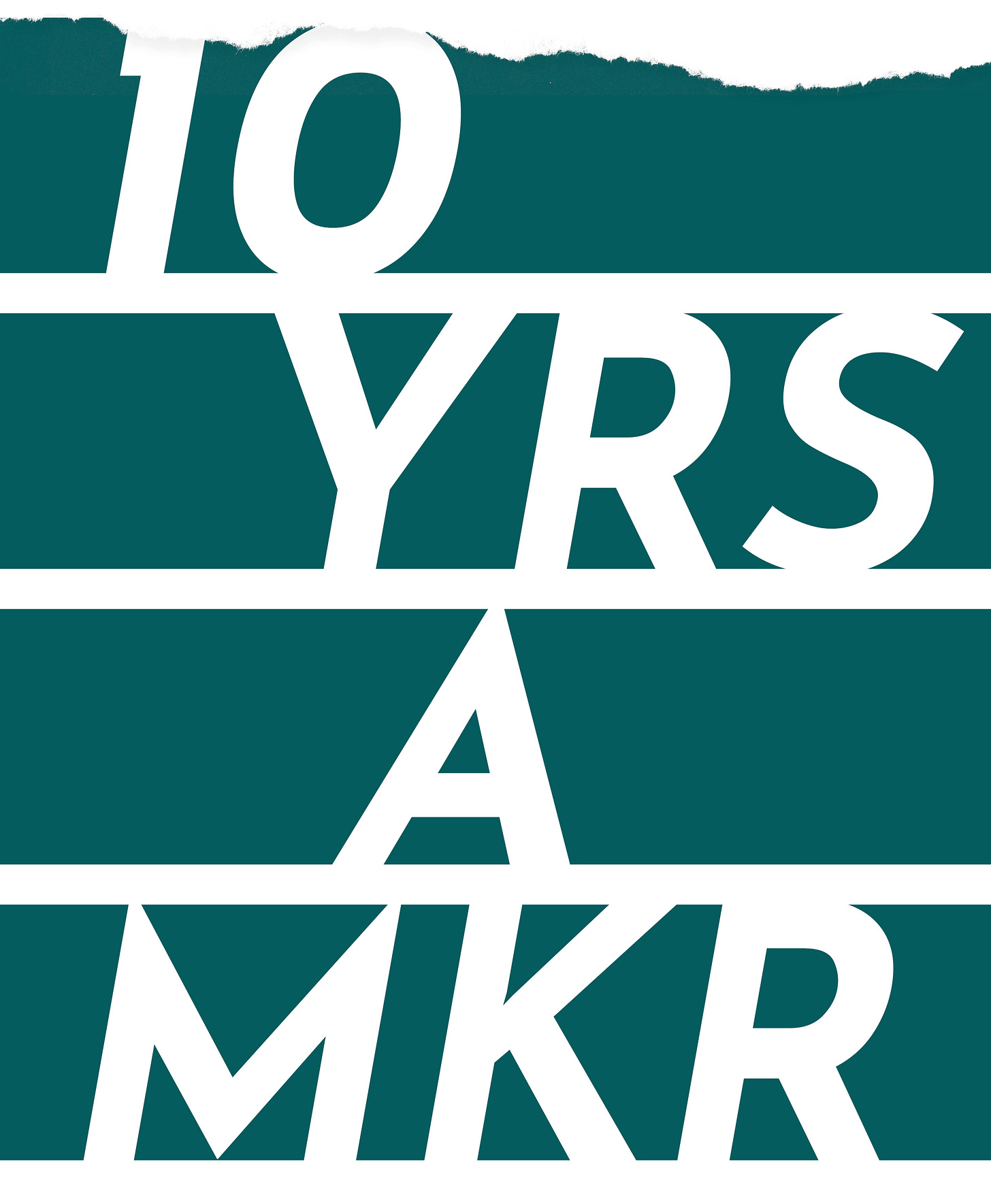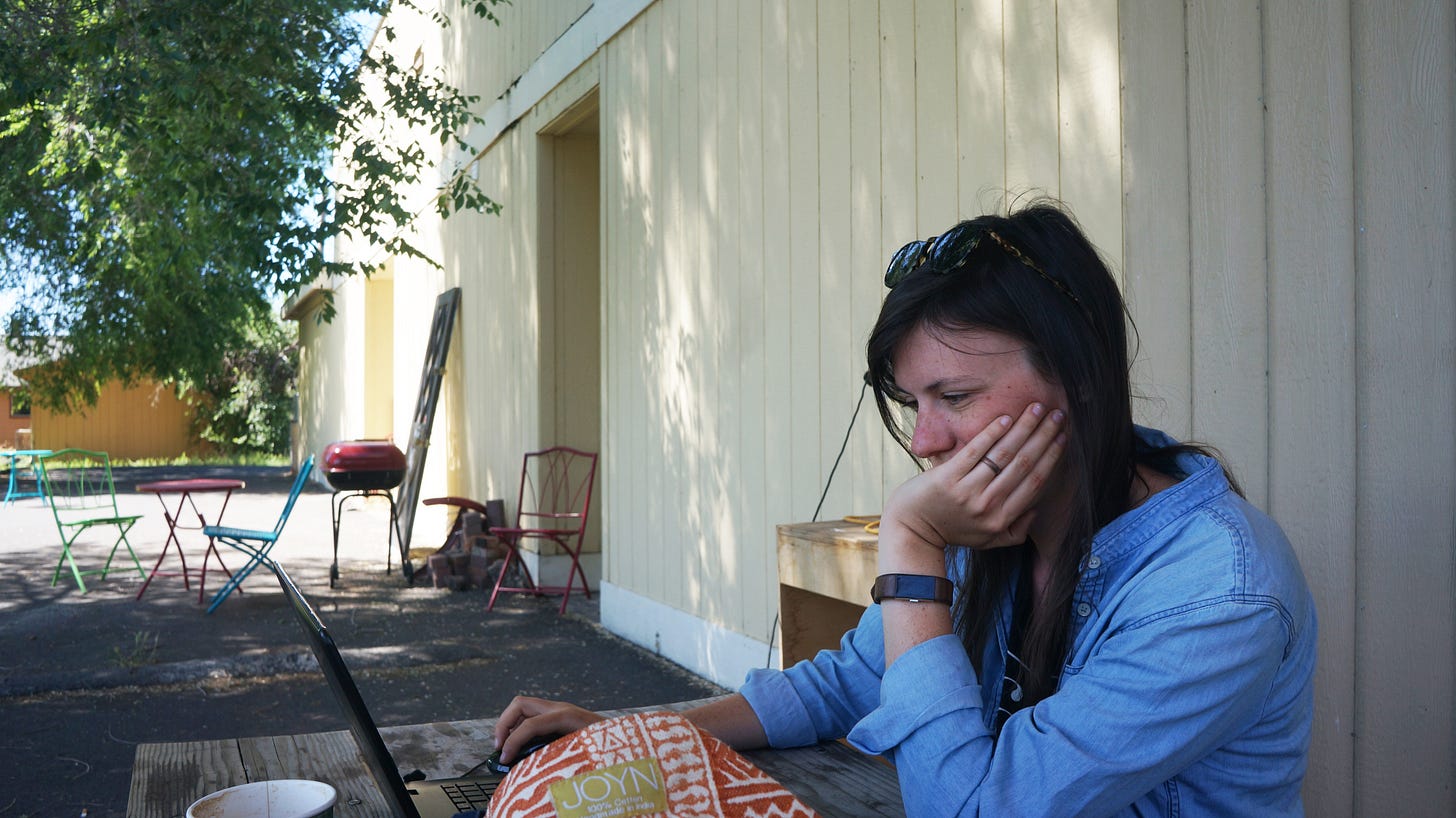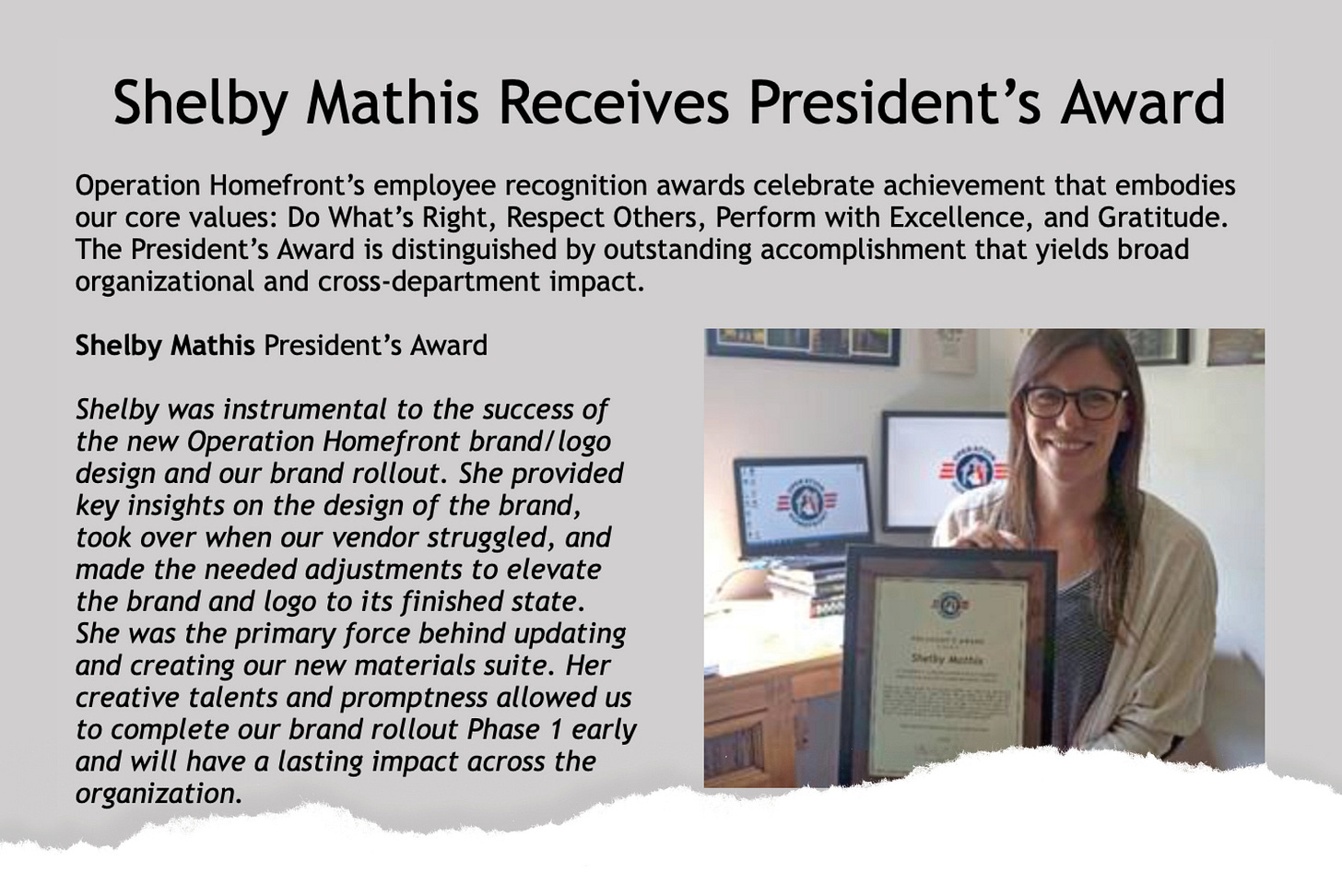10 years a maker: Part one.
my early years as a working artist
I’ve been a maker all my life, but 10 years ago, I started make a living out of it. These days I’m an artist who writes (or a writer who makes art), but my professional job is freelance graphic design.
I’m a small business owner, entrepreneur, sole proprietor. A freelance artist. An independent contractor. And you see, people like me don’t have HR calling them with kudos on work anniversaries. It’s not announced in the employee newsletters. There are no plaques or bonuses. It’s as quiet as silence if I don’t bring it up, but I think it’s worth celebrating. I made it 10 whole years!
The next few editions of Wandering Home will share my story as a graphic designer: how I got started, the early challenges, the weird middle years where I still didn’t really know what I was doing, the growth and highlights of late, and the best lessons learned about design and designing a life.
And because we’re talking design here, these next few issues will be… well, they’ll be designed. Just the way I like it.
Thanks for celebrating with me, my people!
The short of it is this: I presented my senior show. I graduated seven days later with a BFA in graphic design. I got married on the following Saturday and moved to San Antonio, Texas on Thursday. Within a month, my new husband deployed. It was a whirlwind, and it was the sudden loss of everything I knew.
To cure the loneliness, I tried to find work, but there was a recession and I quickly learned no one was hiring entry-level designers with no work experience. I applied for dozens of jobs and only got one interview that went horribly. To build back my courage, I took art classes at the art museum and Southwest School of Art to keep up with my skills and meet new people. But a job is what I really needed.
I started volunteering full-time at the airport USO, American Red Cross, my new church, and military organizations at Lackland Air Force Base, where I lived alone. I found many ways to fill the time, but I still hadn’t found meaningful work in my field.
I'd gotten an administrative job at my church and gained some professional work experience while I published their weekly newsletter, branded ministry projects, and began taking on small freelancing jobs from its members.
One day at work (where, like at home, I had a lot of free time on my hands), I applied to volunteer at Operation Homefront, a national nonprofit that serves military families. I got an email back asking me to come in for a job interview the next week, which seemed excessive for a volunteer gig, but I agreed.
During the interview, I learned the organization had been granted a new full-time AmeriCorps position for a Marketing Specialist. AmeriCorps is a federal program that creates professional roles at nonprofits to help select organizations better fulfill their mission. It seemed like a perfect fit (more so for me than the church office, at least) because it was in my field, and their work was relevant to my own life as a military spouse.
I accepted the AmeriCorps Marketing Specialist position and became the in-house designer for Operation Homefront. I was paid a monthly living stipend by AmeriCorps, and earned a scholarship at the conclusion of my year-long commitment. So, while this wasn't exactly a well-paying full-time job, it had a few helpful benefits and it was the opportunity of a lifetime for me.
I had incredible mentorship and was given responsibilities an entry-level junior designer would never see at an agency or corporation. I had total creative control since there'd never been a designer working for OH (the bar was low, but they trusted my ideas.) Though I had the title “Marketing Specialist”, the team realized my expertise truly lay in design projects and it became my sole focus. It was my dream job for one year, which like any job, meant it was fun sometimes and sucked sometimes.
My AmeriCorps term ended after a year, and I was simultaneously offered a year-long contract as a freelance graphic designer for Operation Homefront to begin after our move to Portugal. I accepted it well before I learned I wouldn't have been able to get a job in my field on Terceira Island. This is how I found myself becoming an accidental freelance graphic designer when I was a military spouse all those years ago.
Such is the military life: my husband got deployment orders again before we were even out of the base hotel and moved into our house on the island. I kept freelancing while he was away.
When my husband returned from deployment, he got stuck in Germany for a week and I flew there to meet him. Not only was this the first time I earned a passport stamp for solo international travel, it was the moment I realized I could travel and work at the same time. My job was incredibly remote, and I was already working odd hours to accommodate the time difference from the U.S. to the Azores. I didn’t need to ask a boss if I could take a few days off (but I did ask because I didn’t know any better and was told “Shelby, you are a contractor, you don’t have to ask for time off. Just tell us when you’re not available.” Say what?!) It felt like unlocking a new level of freedom I’d felt I’d lost to our military life where someone was always telling us when, where, and how to live.
Many military spouses have to sacrifice their own careers, higher education, and professional dreams due to frequent relocations to follow their service member around the globe, to hold down the homefront during deployments and training, or to raise their families while their partner serves their country. There is a misconception that many military spouses don’t desire to or have to work, but the truth is many do want to and they can’t due to these hardships. I didn’t appreciate it until years later that I had a job I loved while my husband was enlisted.
Not only did I love it, I had a job I could and would do anywhere.
For the first time, I was location independent. I traveled like my life depended on it for the next couple of years. More often than not, my desk was a table in a cafe or on the floor of an airport. Armed with only a borrowed PC laptop and spotty Wifi while living fairly nomadically, I built a small but mighty career as a graphic artist.

It was 2015 in Palestine on a trip with my friends Katie and Amber that I began to connect with peacemaking organizations and small businesses with heart that I could really connect to outside of the military space. I realized with my expertise and ability to see real life impact in their local communities, I could use design to help them tell stories to local and global audiences. I collaborated on several package design projects and returned home stewing on the possibility that I could my privilege and visual communication skills to help Palestinians and other communities in need of high-quality, low-cost or free design support.
In the meantime, my husband got new orders to Albuquerque, New Mexico. We packed up my office and the rest of our home and rented a house for nine short months before Lane would separate from the Air Force at the end of his enlistment. As we figured out what was next, I leaned more on Operation Homefront as my sole client. They were reliably consistent work for me, and I saw how my experience was growing alongside the rapidly evolving organization I’d joined forces with a few years prior.
When it was time to depart New Mexico and the military, we set off temporarily for rural Missouri to make some long-term plans. We rented a barn and lived there off and on for the fall and winter when we weren’t traveling or WWOOF-ing. It was on the farm in Tennessee we decided to make the move to Colorado for Lane to go to film school on the G.I. Bill.
I was struggling personally with the many transitions and some trauma in my own life and decided to take a break from mission work (though I’d barely begun.) I committed to pursuing new work opportunities and clients, and worked to grow my small business into something more sustainable for our post-military future.
Shortly after we moved to Denver, we went on a long climbing roadtrip. You’d have found me working every other day from cafes and gear shops across the Pacific Northwest and B.C. Canada for roughly two months. While work wasn’t one of the trip highlights, I loved the way being in a coffee shop for hours at a time would build community. I was constantly meeting new people to talk or climb with. I was able to keep in touch with family, and my clients hardly missed me because I showed up every time I promised I would. It was tricky to balance some days, but I left the trip with every client I started with and no unmet expectations with work, just as I’d done on all of my other travels.
By 2017, I’d traveled to and worked from 10 different countries.
With my ear to the ground when we returned to Colorado, I was referred to two new clients, Invisible Children and Museum of the Palestinian People, and a couple one-off projects for small businesses. While I did take on some for-profit projects, the recurring theme of non-profits couldn’t have been more evident.
With nearly five years of experience in the sector, I realized the edge and strengths I’d developed: I understood their diverse audiences, I’d proven an ability to work cross-culturally, and I was more than willing to provide excellent design at an affordable cost to non-profits often on a shoestring budget. I realized I had organically narrowed my focus.
I had to kick it into high gear in 2017 once we’d settled in to Denver. Lane was going to college, and though his VA benefits covered tuition and our housing, I needed to grow my revenue to make a meaningful contribution to our household. Luckily, great opportunities were on the way.
A newer client of mine, Invisible Children, hired me to design a 35-page grant proposal on short order. Not only did we turn it around in just a few days, they were awarded the multi-year, highly coveted USAID grant they’d been after which allowed them to build new programs and open new field offices in Central Africa.
Shortly after the IC proposal was submitted, Operation Homefront set out to rebrand, including redesigning their logo. A large marketing firm was brought on to design it, but their ideas and execution weren’t cutting it as we got farther and farther into the process. I was called in for consult by the OH marketing team, pitched my own ideas for improving the drafts on-the-spot and landed myself the lead design role on the logo and the rebrand rollout. I nailed the refresh and was awarded the President’s Award by the OH President & CEO, John Pray. Here’s an excerpt from Around the Homefront, the Operation Homefront internal newsletter:
I still handle the majority of OH collateral, so I know where the logo will end up most of the time. But over the years there have been a few fun surprises. I’ve had the unique pleasure of seeing my logo out in the wild on campaign posters in Dollar Tree and Walmart, and on packaging of Chobani and Pillsbury products in my own grocery store. It’s incredibly satisfying to run across my work in print by chance.
I’d been successfully maintaining a slow and steady work rhythm for a few years in order to travel and move frequently. But after the IC proposal and the OH logo redesign, I was gaining confidence as a designer and starting to feel my creativity needing to come alive in new ways. I started writing and publishing on a friend’s blog a weekly column I called “On Belay”, and I was ready to take the next steps in building my fledgling design business.
Read Part Two here.
Onward,

















Love this! I’m not as traumatized as I once was lol. Great writing as expected ❤️